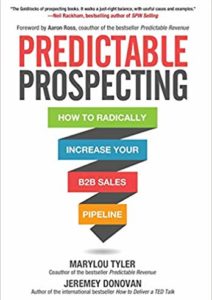There are only 3 things you need to know to generate predictable revenue for your business:
- Sticky product/service: Your products that generate the highest revenue potential with the highest likelihood of closing
- Pipeline: A scalable process for converting prospects into clients
- Time: How long it takes to convert a prospect into a client
And that’s it.
Get these three things right and every day is one big party.
Master them, and the sky’s the limit.
Get them wrong… well I think most of you know what that’s like, right?
I’ve outlined a few tips you can implement now as you work towards predictable revenue mastery for your book of business.
Sticky Product / Service
The characteristics of a sticky product or service include:
- High profit margins
- High revenue potential
- Long lifetime value
- High[er] close rates
- Large[er] number of people who want or can use this product or service
Tip to Action
Make a list of the products and services you sell now and prioritize in order of highest revenue potential with highest probability of closing. Typically in a larger company you’ll come up with 2-3 products that fit the criteria.
Pipeline
For every sales and marketing professional who answers it depends when asked a question about close rates, conversion rates by lead type, pipeline leakage and lag, it is clear they have a dysfunctional sales process in place.
Don’t let this be you.
You cannot have predictability without having repeatable processes.
You cannot make something repeatable if you are not regularly measuring what matters.
You cannot measure what matters if you’re capturing what I call vanity metrics (# dials, #emails sent, # of people reached, etc.).
Here are some quick tips to shift from chaos to predictability…
Tip to Action — Identify Your Lead Streams:
Each lead stream that feeds your pipeline (inbound, word-of-mouth, cross-sell/up-sell, outreach, partners, etc.) has different fundamental attributes:
- How well they qualify
- How fast they close
- How much control you have over the quantity and quality
- Their return-on-investment
- How much value they bring to your organization
- And so on…
I believe the outreach lead stream lays a solid foundation for predictable revenue:
- You target accounts and contacts that represent your ideal customer profile
- You control the quantity and quality of targets
- From initial contact through close, everything is systematically process-driven
Tip to Action – Map Your Current Sales Process
This is back-of-the-napkin stuff. Get out a pencil and draw what happens from when a lead comes in to your pipeline until it goes out. Look for and draw the steps or stages along the pipeline. Here’s a sample outreach Cold to Opportunity pipeline of one of my clients:
- Cold – contacts in this queue have not been touched, but represent ideal customers (high revenue potential, high probability of closing)
- Cold-Active – e-mail and phone sequences have been started – looking for a response, internal referral, high click-throughs on call-to-action e-mail pieces, etc.
- Working – dialog has been started, getting ready to schedule are-we-a-fit calls for qualification
- Qualifying – Are-we-a-fit call has been completed, ready for additional discovery, demos, additional stakeholder identification, in-depth qualification. (Note: Sometimes Working and Qualifying are collapsed into one queue. If your qualification process is accomplished on one phone call, then one queue is usually sufficient.)
- Opportunity – Stage 1. Identified – Qualification completed, product or service need identified, criteria met to justify additional company resource assignment to the opportunity
Tip to Action: Identify Key Actionable Metrics
The goal for this step is to streamline and synthesize metrics to the 4-6 meaningful activities or results you think are drivers for predictability. Here are predictability metrics I use with clients:
- # leads per month by lead stream (inbound, outreach, referral, partner, etc.)
- conversion rate of leads to opportunity
- # qualified opportunities created per month; pipeline $$ opportunities per month
- conversion rate of opportunities to closed deals
- booked revenue – new business; add-on business; renewal business (where applicable)
- intra-queue conversion rates, lag and leakage rates
Tip to Action: Create Improved Pipeline Steps & Start Tracking Actionable Metrics
After you review your current pipeline steps and metrics, create a leaner, actionable version of the pipeline.
Pipeline Added Benefit
For the pipeline stage example I gave you above, I’m able to look at intra-queue conversion rates for all meaningful activities at the top of the pipeline (Cold queue through Qualifying queue). This clarity amplifies whether I have skills issues with my sales reps or whether I’m not pumping in enough volume to generate my desired outcomes. Do you have this visibility now, with your current pipeline setup?
Time
There are three time parameters to consider:
- Onboarding (new rep training [culture, product, CRM, etc.])
- Cold –> Qualifying (leads to qualified opportunities)
- Qualifying -> Close (qualified opportunities to close)
This is another area where I get the it depends answer most often. It depends is the antithesis of predictability. I find pipeline lag [and leakage to some extent] is most effectively tracked via timers.
Tip to Action: Put Timers Into Your Pipeline.
Here’s where I put timers in for my clients:
- Cold-Active: As soon as a human touches a lead for the first time, the timer starts. I don’t worry about timers for non-human stuff since that is [usually] time-stamped for me.
- Working: I put a timer here because I want to know if we’re going to run into a skills issue (lack of sales training). Leads stuck in Working usually speaks volumes for inadequate sales skills training, or wrong person for the role at this queue position in the pipeline.
- Qualifying: I put a timer here because once again, I want to know if we made it through the are-we-a-fit sequence, but are stuck trying to get the qualification criteria. Or lack a strong pending event… or a compelling reason to move forward… or a weak call-to-action was specified in the previous queue. (Note: Remember from above, the Working/Qualifying queue may be collapsed into one queue if your qualification process is performed on one call.)
- Opportunity: Usually CRMs are good about time-stamping Opportunity to Close steps. If you’ve done the map from the Pipeline section above, you may want to insert a timer to review lag statistics from major milestone steps.
Assemble, Activate, Assess
The tips above focus your efforts on the assembly portion of a predictable pipeline. Your work does not end there. Next steps:
- Activate your changes
- Run in production until you have a meaningful sample (one week at full production should do it)
- Assess your results
- Modify / enhance
- Iterate
- Assess
- Repeat the Modify to Assess steps
Share your results with peers, colleagues, friends, and me. We all want the same thing; the more knowledge and experiences we share with our community, the sooner we will reach our goals.
***













